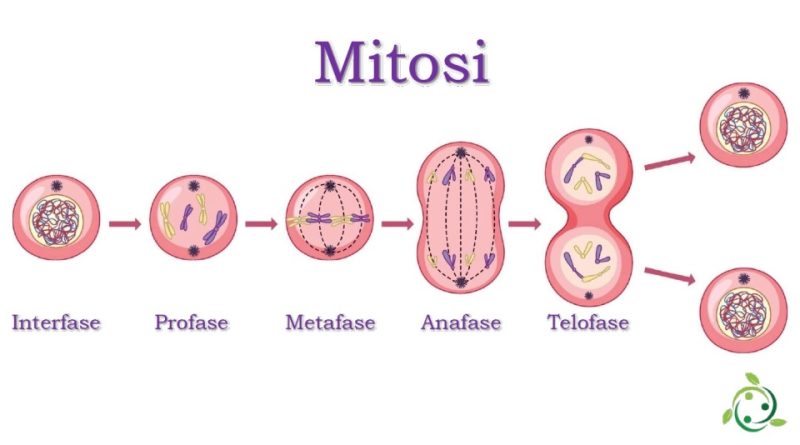Mitosis
Mitosis
Mitosis (or karyokinesis or cell division) is the typical way of reproduction of somatic cells and consists of the process of cell division which gives rise to two daughters with genetic patrimony equal to that of the mother cell, from which they therefore also inherit the same functions.
The term mitosis derives from the English mitosis, which in turn comes from the Greek μίτος, i.e. thread.
Mitosis is therefore the reproductive phase of the cell cycle of eukaryotic organisms, in which 2 daughter cells genetically identical to the mother cell are formed from a single cell.
The mitosis process affects both the somatic cells of the organism and the still undifferentiated germ cells and forms cells with the same number of chromosomes as the cell of origin.
Mitosis differs from meiosis, where there is the transmission of a single copy of the chromosomal set and therefore its halving.
Cell cycle –
In living organisms the cell cycle is divided into three phases: the interphase, which is the moment in which the cell performs its vital functions and prepares for division; mitosis, in which the cell divides; cytokinesis (cytokinesis), i.e. the division of the cell’s cytoplasm to form two identical daughter cells.
Mitosis proper is short-lived compared to the entire cell cycle process, which is largely occupied by interphase.
During interphase the cell performs its specific functions and grows; the organelles of the cell increase and allow its duplication.
The interphase, in turn, is divided into three sub-phases: two control phases G1 and G2, where the letter G indicates the initial of the term Gap (from the English interval), during which the cell verifies that the DNA has not undergone serious mutations, and a synthesis phase (S).
In the G1 phase the synthesis of specific molecules of the cell takes place (specific metabolism) and it is the phase of the cell’s life itself; in the S phase the cell duplicates its DNA through a process called DNA duplication, in which the chromosomes obtain, for each, two identical sister chromatids, which in the phase of maximum condensation are associated with each other at the centromere level.
Finally we have the G2 phase, during which the polymerization and organization for the organelles takes place and the last checks of the integrity of the DNA are carried out. If there are no mutations or serious alterations, we proceed with the actual mitosis.
Stages of mitosis –
Mitosis is divided into five stages, which are:
– prophase;
– pro metaphase;
– metaphase;
– anaphase;
– telophase.
Prophase –
Prophase is the first stage of cell division both in the process of mitosis and meiosis, in which the nuclear chromatin, which initially appears in the form of small lumps or in a reticulum, organizes itself, through a complex process of spiralization, to form the chromosomes , which gradually become shorter and more colourable; towards the end of the prophase the centrioles move away, while the disappearance of the nucleoli and the progressive dissolution of the nuclear membrane coincide with the beginning of the metaphase.
Pro metaphase –
Pro metaphase represents the initial stage of metaphase, during which progressive dissolution of the nuclear envelope takes place.
Metaphase –
Metaphase is that phase of mitosis or meiosis in which the chromosomes arrange themselves in the equatorial plate.
Anaphase –
Anaphase is the third phase of the division of the cell nucleus, characterized by the splitting of the centromeres present in the chromosomes, by the separation of the two chromatids that were attached to them and by their migration to the spindle poles.
Telophase –
Telophase is the final moment of the nuclear division process, for both meiosis and mitosis, in the reproduction of the cell (which is normally followed by cell division).

